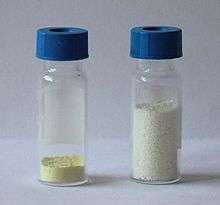Graphitic carbon nitride

Graphitic carbon nitride (g-C3N4) is a family of carbon nitride compounds with a general formula near to C3N4 (albeit typically with non-zero amounts of Hydrogen) and two major substructures based on heptazine and Poly(Triazine imide) units which, depending on reaction conditions, exhibit different degrees of condensation, properties and reactivities.
Preparation
Graphitic carbon nitride can be made by polymerization of cyanamide, dicyandiamide or melamine. The firstly formed polymeric C3N4 structure, melon, with pendant amino groups, is a highly ordered polymer. Further reaction leads to more condensed and less defective C3N4 species, based on tri-s-triazine (C6N7) units as elementary building blocks.[2]
Graphitic carbon nitride can also be prepared by electrodeposition on Si(100) substrate from a saturated acetone solution of cyanuric trichloride and melamine (ratio =1: 1.5) at room temperature.[3]
Well-crystallized graphitic carbon nitride nanocrystallites also can be have prepared via benzene-thermal reaction between C3N3Cl3 and NaNH2 at 180–220 °C for 8–12 h.[4]
Recently, a new method of syntheses of graphitic carbon nitrides by heating at 400-600 °C of a mixture of melamine and uric acid in the presence of alumina has been reported. Alumina favored the deposition of the graphitic carbon nitrides layers on the exposed surface. This method can be assimilated to an in situ chemical vapor deposition (CVD).[5]
Characterisation
Characterisation of crystalline g-C3N4 can be carried out by identifying the triazine ring existing in the products by X-ray photoelectron spectroscopy (XPS) measurements, photoluminescence spectra and Fourier transform infrared spectroscopy (FTIR) spectrum (peaks at 800 cm−1, 1310 cm−1 and 1610 cm−1).[4]
Properties
Due to the special semiconductor properties of carbon nitrides, they show unexpected catalytic activity for a variety of reactions, such as for the activation of benzene, trimerization reactions, and also the activation of carbon dioxide (artificial photosynthesis).[2]
Uses
A commercial graphitic carbon nitride is available under the brand name Nicanite. In its micron-sized graphitic form, it can be used for tribological coatings, biocompatible medical coatings, chemically inert coatings, insulators and for energy-storage solutions.[6] Graphitic carbon nitride is reported as one of the best hydrogen storage materials.[7][8] It can also be used as a support for catalytic nanoparticles.[1]
Areas of interest
Due to their properties (primarily large, tuneable band gaps and efficient intercalation of salts) graphitic carbon nitrides are under research for a variety of applications:
- Photocatalysts
- Decomposition of water to H2 and O2[9]
- Degradation of pollutants
- Large band gap semiconductor[10]
- Heterogeneous catalyst and support
- The significant resilience of carbon nitrides combined with surface and intralayer reactivities make them potentially useful catalysts relying on their labile protons and Lewis base functionalities. Modifications such as doping, protonation and molecular functionalisation can be exploited to improve selectivity and performance.[11]
- Nanoparticle catalysts supported on gCN are under development for both proton exchange membrane fuel cells and water electrolyzers.[10]
- Energy Storage materials
- Due to the intercalation of Li being able to occur to more sites than for graphite due to intra layer voids in addition to intercalation between layers, gCN can store a large amount of Li[12] making them potentially useful for rechargeable batteries.
See also
References
| Wikimedia Commons has media related to Graphitic carbon nitride. |
- 1 2 Chen, Xiufang; Zhang, Ligang; Zhang, Bo; Guo, Xingcui; Mu, Xindong (2016). "Highly selective hydrogenation of furfural to furfuryl alcohol over Pt nanoparticles supported on g-C3N4 nanosheets catalysts in water". Scientific Reports. 6: 28558. Bibcode:2016NatSR...628558C. doi:10.1038/srep28558. PMC 4916514. PMID 27328834.
- 1 2 Thomas, A.; Fischer, A.; Goettmann, F.; Antonietti, M.; Müller, J.-O.; Schlögl, R.; Carlsson, J. M. (2008). "Graphitic Carbon Nitride Materials: Variation of Structure and Morphology and their Use as Metal-Free Catalysts". Journal of Materials Chemistry. 18 (41): 4893–4908. CiteSeerX 10.1.1.529.6230. doi:10.1039/b800274f.
- ↑ Li, C.; Cao, C.; Zhu H. (2003). "Preparation of Graphitic Carbon Nitride by Electrodeposition". Chinese Science Bulletin. 48 (16): 1737–1740. doi:10.1360/03wb0011.
- 1 2 Guo, Q. X.; Xie, Y.; Wang, X. J.; Lv, S. C.; Hou, T.; Liu, X. M. (2003). "Characterization of Well-Crystallized Graphitic Carbon Nitride Nanocrystallites via a Benzene-Thermal Route at Low Temperatures". Chemical Physics Letters. 380 (1–2): 84–87. Bibcode:2003CPL...380...84G. doi:10.1016/j.cplett.2003.09.009.
- ↑ Dante, R. C.; Martín-Ramos, P.; Correa-Guimaraes, A.; Martín-Gil, J. (2011). "Synthesis of Graphitic Carbon Nitride by Reaction of Melamine and Uric Acid". Materials Chemistry and Physics. 130 (3): 1094–1102. doi:10.1016/j.matchemphys.2011.08.041.
- ↑ "Nicanite, Graphitic Carbon Nitride". Carbodeon.
- ↑ Nair, Asalatha A. S.; Sundara, Ramaprabhu; Anitha, N. (2015-03-02). "Hydrogen storage performance of palladium nanoparticles decorated graphitic carbon nitride". International Journal of Hydrogen Energy. 40 (8): 3259–3267. doi:10.1016/j.ijhydene.2014.12.065.
- ↑ Nair, Asalatha A. S.; Sundara, Ramaprabhu (2016-05-12). "Palladium Cobalt Alloy Catalyst Nanoparticles Facilitated Enhanced Hydrogen Storage Performance of Graphitic Carbon Nitride". The Journal of Physical Chemistry C. 120 (18): 9612–9618. doi:10.1021/acs.jpcc.6b01850.
- ↑ Wang, Xinchen; Maeda, Kazuhiko; Thomas, Arne; Takanabe, Kazuhiro; Xin, Gang; Carlsson, Johan M.; Domen, Kazunari; Antonietti, Markus. "A metal-free polymeric photocatalyst for hydrogen production from water under visible light". Nature Materials. 8 (1): 76–80. doi:10.1038/nmat2317.
- 1 2 Mansor, Noramalina; Miller, Thomas S.; Dedigama, Ishanka; Jorge, Ana Belen; Jia, Jingjing; Brázdová, Veronika; Mattevi, Cecilia; Gibbs, Chris; Hodgson, David. "Graphitic Carbon Nitride as a Catalyst Support in Fuel Cells and Electrolyzers". Electrochimica Acta. 222: 44–57. doi:10.1016/j.electacta.2016.11.008.
- ↑ Thomas, Arne; Fischer, Anna; Goettmann, Frederic; Antonietti, Markus; Müller, Jens-Oliver; Schlögl, Robert; Carlsson, Johan M. (2008-10-14). "Graphitic carbon nitride materials: variation of structure and morphology and their use as metal-free catalysts". Journal of Materials Chemistry. 18 (41). doi:10.1039/b800274f. ISSN 1364-5501.
- ↑ Wu, Menghao; Wang, Qian; Sun, Qiang; Jena, Puru (2013-03-28). "Functionalized Graphitic Carbon Nitride for Efficient Energy Storage". The Journal of Physical Chemistry C. 117 (12): 6055–6059. doi:10.1021/jp311972f. ISSN 1932-7447.